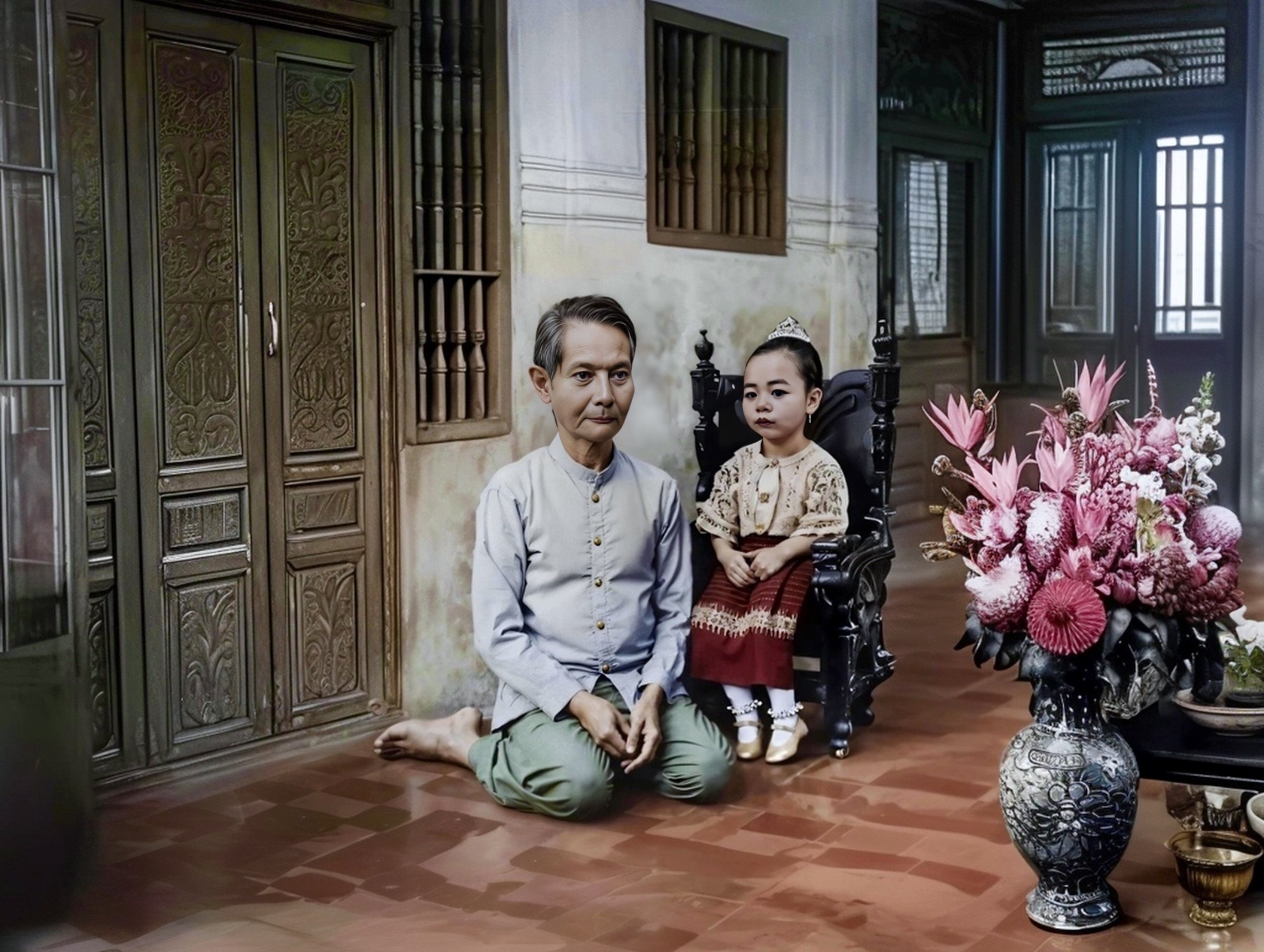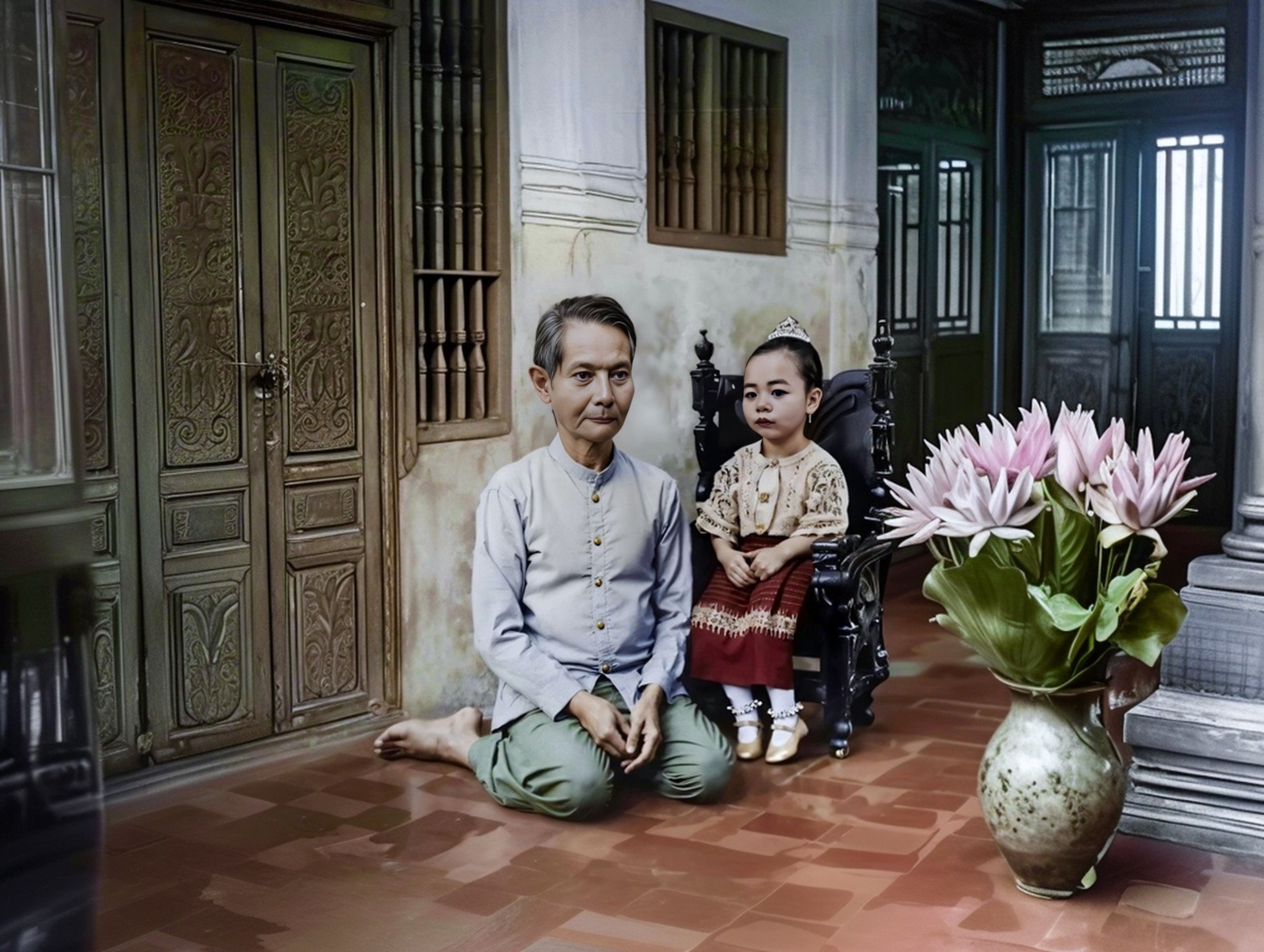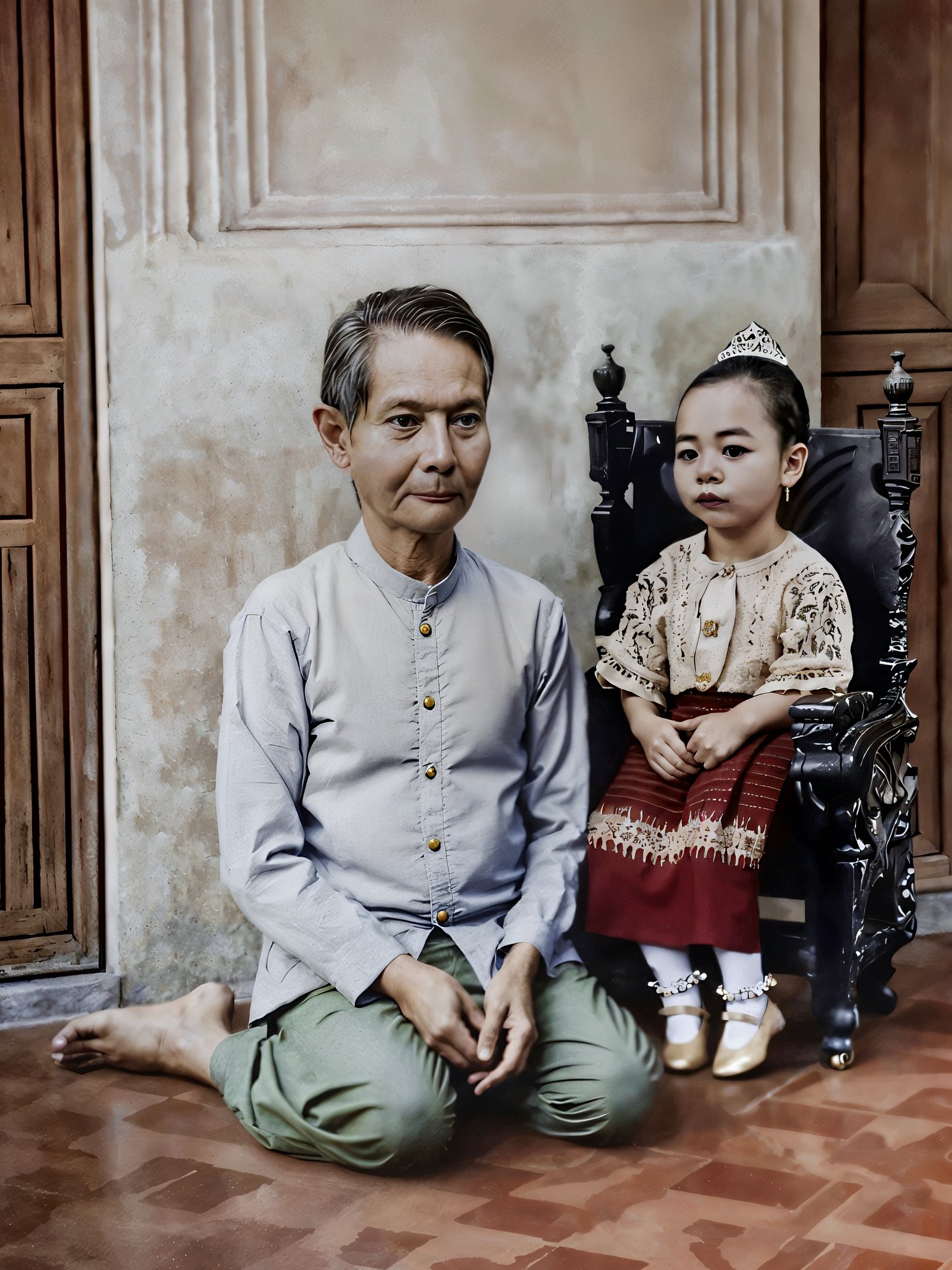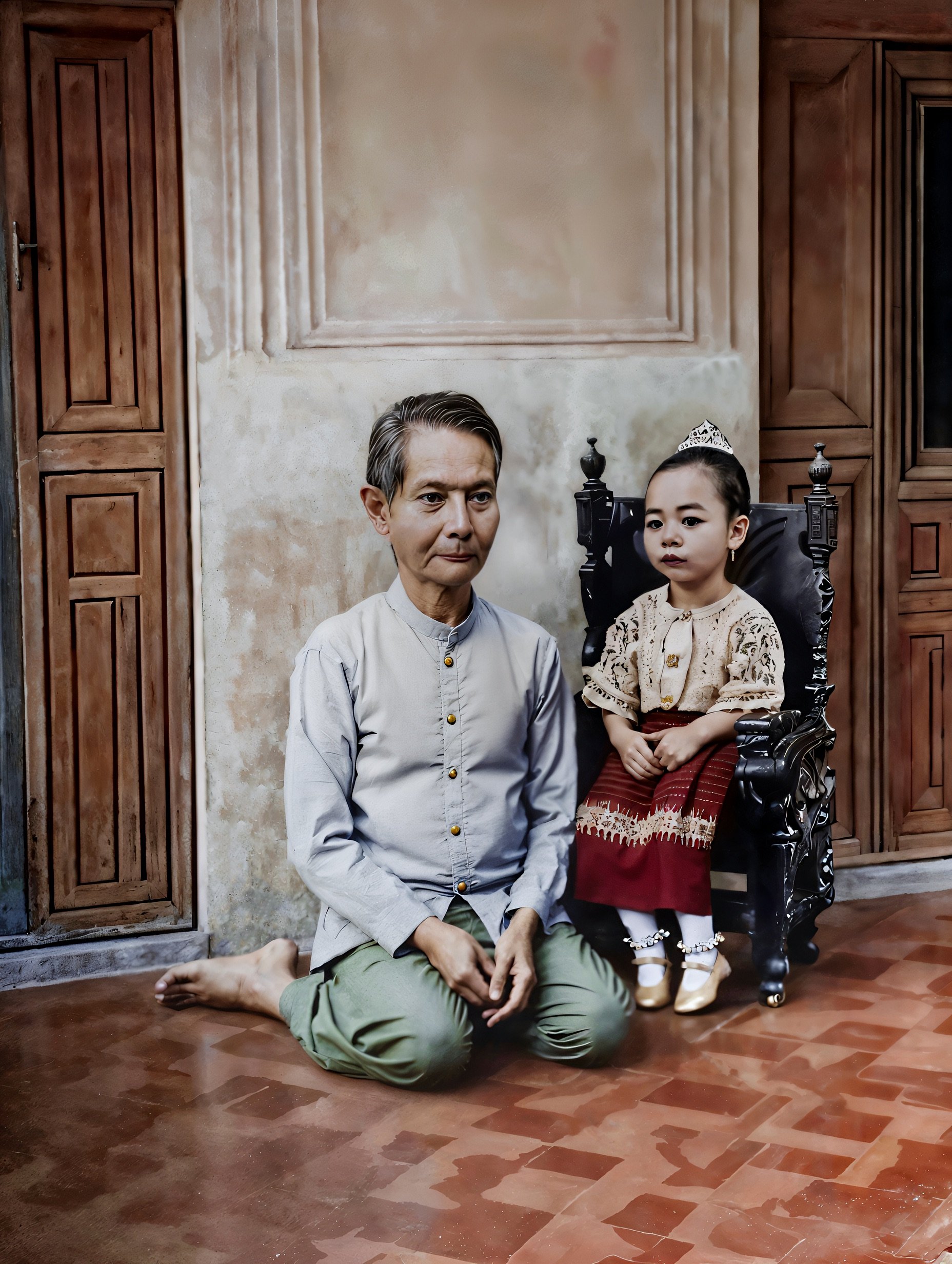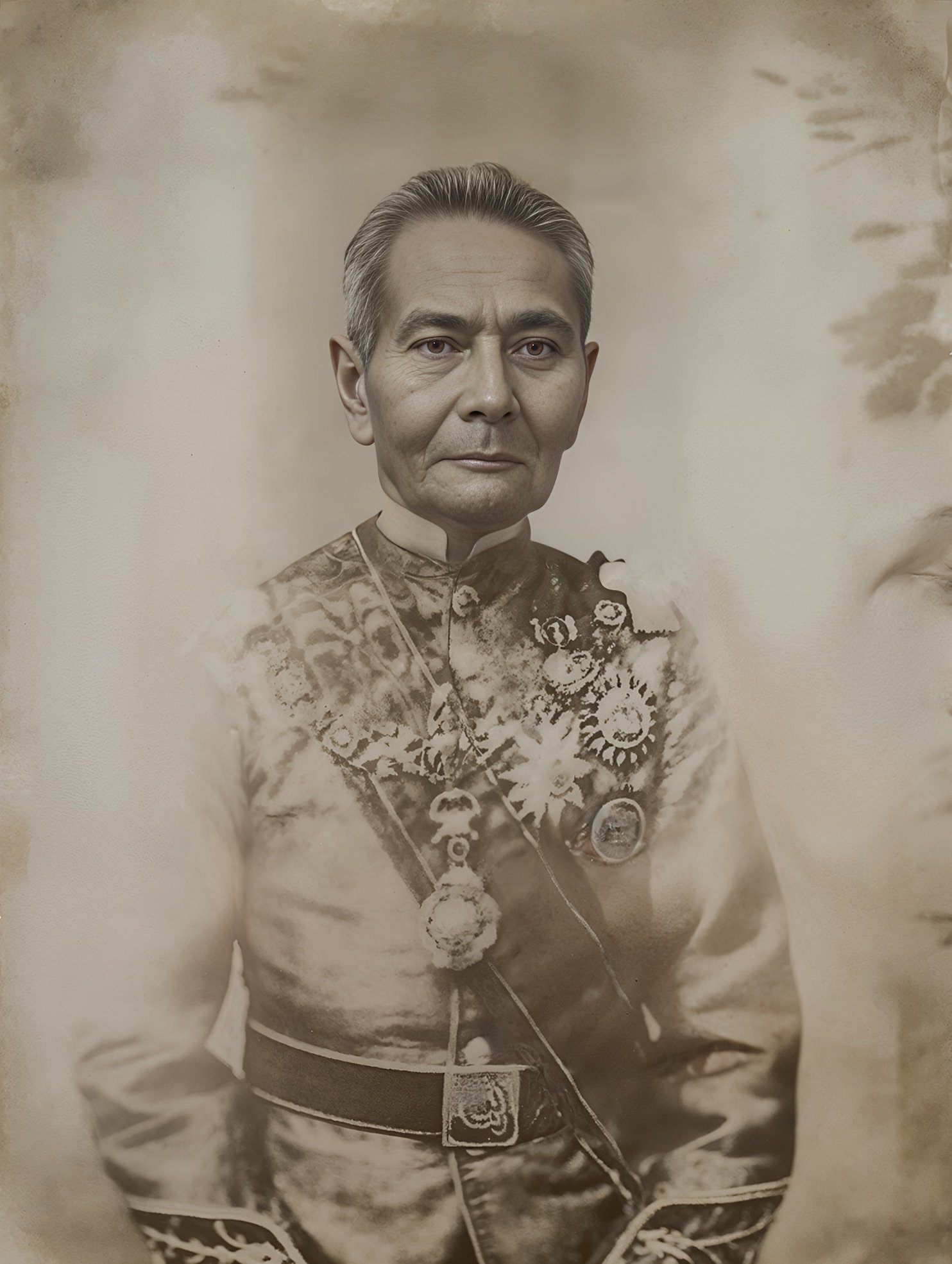การบูรณะภาพถ่ายประวัติศาสตร์ด้วย AI: ภาพเจ้าพระยารัตนาธิเบศร์และสมเด็จพระเจ้าบรมวงศ์เธอ พระองค์เจ้าวิมลนาคนพีสี
การบูรณะภาพถ่ายประวัติศาสตร์ด้วย AI: ภาพเจ้าพระยารัตนาธิเบศร์และสมเด็จพระเจ้าบรมวงศ์เธอ พระองค์เจ้าวิมลนาคนพีสี
การอนุรักษ์และฟื้นฟูภาพถ่ายทางประวัติศาสตร์เป็นความท้าทายและน่าสนใจ โดยเฉพาะอย่างยิ่งเมื่อภาพต้นฉบับไม่ชัดเจนหรือเสื่อมสภาพไปตามกาลเวลา โปรเจ็คเล็กๆ ของผมนี้เกี่ยวข้องกับการสร้างสรรค์ใหม่ของภาพถ่ายของ เจ้าพระยารัตนาธิเบศร์ (พุ่ม ศรีไชยันต์) และสมเด็จพระเจ้าบรมวงศ์เธอ พระองค์เจ้าวิมลนาคนพีสี (ออกเสียงว่า วิ-มน-นาก-นะ-พี-สี)) พระราชธิดาในพระบาทสมเด็จพระจุลจอมเกล้าเจ้าอยู่หัวกับพระราชชายาเจ้าดารารัศมี ภาพต้นฉบับเป็นภาพขาวดำจากหนังสือพิมพ์หรือวารสารเก่า ซึ่งเสื่อมสภาพอย่างมากจนไม่สามารถมองเห็นรายละเอียดได้อย่างชัดเจน ผมได้สร้างสรรค์ภาพใหม่ที่ผ่านการลงสีและฟื้นฟูรายละเอียดของภาพให้กลับมามีชีวิตอีกครั้งผ่านการใช้เครื่องมือ AI และการสร้างสรรค์เชิงศิลปะ ภาพต้นฉบับได้รับการอนุเคราะห์จากแฟนเพจท่านหนึ่งครับ
ความท้าทายและกระบวนการบูรณะภาพเก่า
การบูรณะภาพภาพนี้มีความซับซ้อนเป็นพิเศษ เนื่องจากคุณภาพของภาพต้นฉบับต่ำมาก ในการสร้างภาพที่มีความใกล้เคียงกับบุคคลจริงทั้งสองคนนี้ ผมใช้ภาพสองภาพเป็นข้อมูลอ้างอิง ได้แก่ ภาพของสมเด็จพระเจ้าบรมวงศ์เธอ พระองค์เจ้าวิมลนาคนพีสีจากคอลเล็กชันส่วนตัวของผม และภาพของเจ้าพระยารัตนาธิเบศร์จากวิกิพีเดีย กระบวนการทำงานประกอบด้วยการปรับแต่งใบหน้าให้ชัดเจนและถูกต้องก่อนลงสี รวมถึงการออกแบบเครื่องแต่งกายใหม่ เนื่องจากรายละเอียดเครื่องแต่งกายในภาพต้นฉบับไม่สามารถมองเห็นได้อย่างชัดเจน
องค์ประกอบที่โดดเด่นที่สุดของภาพต้นฉบับคือการจัดท่านั่งของสมเด็จพระเจ้าบรมวงศ์เธอ พระองค์เจ้าวิมลนาคนพีสี ซึ่งนั่งอยู่ที่ปลายของเก้าอี้ยาวหรือตั่ง โดยที่วางแขนของเก้าอี้พาดผ่านตัวพระองค์ ในกระบวนการออกแบบใหม่ ผมปรับให้พระองค์ประทับอยู่บนเก้าอี้ตัวเล็กแทน แต่ยังคงรักษาลักษณะบางส่วนของเก้าอี้ เช่น ลูกบิดที่พนักพิง เพื่อให้ยังคงเชื่อมโยงกับภาพต้นฉบับ การออกแบบฉากหลังใหม่ของภาพได้รับแรงบันดาลใจจากบรรยากาศภายใน พระตำหนักของพระราชชายาเจ้าดารารัศมี ซึ่งใช้ภาพถ่ายภายในพระตำหนักเป็นแนวทางในการสร้างฉาก
การออกแบบเครื่องแต่งกายและบริบททางประวัติศาสตร์
เนื่องจากสมเด็จพระเจ้าบรมวงศ์เธอ พระองค์เจ้าวิมลนาคนพีสี ประสูติเมื่อวันที่ 2 ตุลาคม พ.ศ. 2432 (ค.ศ. 1889) ผมคาดว่าภาพต้นฉบับน่าจะถ่ายถ่ายในช่วงปี พ.ศ. 2434-35 เพื่อให้สอดคล้องกับยุคสมัย ผมออกแบบเครื่องแต่งกายใหม่ของพระองค์ให้เป็น เสื้อลูกไม้แบบสมัยวิคตอเรีย แบบสมัยรัชกาลที่ ๕ และทรง ผ้าซิ่นตีนจกเชียงใหม่แบบยกดิ้นทอง (ซิ่นต๋า ซิ่นตีนจกยกดิ้นทอง)สำหรับเจ้าพระยารัตนาธิเบศร์ ผมออกแบบ เสื้อคอจีนแบบลำลอง ติดกระดุมทองเล็ก 5 เม็ด พร้อม โจงกระเบนสีเขียว ซึ่งสะท้อนถึงสถานะของท่านในฐานะขุนนางชั้นผู้ใหญ่ในสมัยรัชกาลที่ ๕
องค์ประกอบทางวัฒนธรรมในฉากหลังของภาพ
ผมคาดว่าภาพต้นฉบับน่าจะถ่ายในสตูดิโอถ่ายภาพแห่งหนึ่งในกรุงเทพฯ ซึ่งเป็นธรรมเนียมปฏิบัติทั่วไปของบรรดาขุนนางไทยในสมัยนั้น อย่างไรก็ตาม ในการสร้างภาพใหม่ ผมเลือกให้ฉากอยู่ภายใน พระตำหนักของพระราชชายาเจ้าดารารัศมี ในเชียงใหม่ เพื่อให้ภาพมีความใกล้เคียงกับวัฒนธรรมล้านนาและการตกแต่งภายในสมัยรัชกาลที่ ๕ และบริบททางประวัติศาสตร์มากขึ้น รูปแบบการนั่งบนพื้นซึ่งเป็นเอกลักษณ์ของขนบไทยยังคงถูกนำมาใช้ เพื่อรักษาบรรยากาศของยุคสมัยนั้น
บทบาทของ AI ในการสร้างสรรค์ภาพในประวัติศาสตร์
กาบูรณะภาพถ่ายเก่าให้กลับมามีชีวิตอีกครั้ง ต้องใช้เครื่องมือ AI หลายตัวที่ทำงานร่วมกันเพื่อปรับปรุงรายละเอียดต่าง ๆ ได้แก่:
PhotoAid Photo Enlarger – ปรับแต่งความคมชัดหน้าและขยายภาพให้มีความคมชัดขึ้น
PicSi AI – ใช้ปรับโครงหน้าของบุคคลให้ถูกต้องแม่นยำ
Midjourney Editing Suite – ใช้สร้างเครื่องแต่งกายและฉากหลังให้ตรงกับยุคสมัย
Krea Editing Suite – ใช้สร้างเครื่องแต่งกายและฉากหลังให้ตรงกับยุคสมัย
Magnific AI – ปรับรายละเอียดของเครื่องแต่งกายและโครงหน้าให้สมจริงขึ้น
Aiarty Enhancer – ทำให้ภาพมีความคมชัดและสมบูรณ์มากขึ้น
Photoshop – ใช้ในการเก็บรายละเอียดสุดท้ายให้ภาพออกมาสมบูรณ์ที่สุด
บริบททางประวัติศาสตร์: ความสนพระทัยของอังกฤษที่มีต่อพระราชชายาเจ้าดารารัศมี
เป็นที่น่าสังเกตว่า เจ้าพระยารัตนาธิเบศร์ (พุ่ม ศรีไชยันต์) ซึ่งดำรงตำแหน่ง พระยาเทพประชุน ข้าหลวงใหญ่เมืองเชียงใหม่ ตั้งแต่ปี พ.ศ. 2417 เป็นผู้ตั้งพระนามให้ เจ้าดารารัศมี และ เจ้าจันทรโสภา พระเชษฐภคินีของพระองค์
ในปี พ.ศ. 2426 ข่าวลือทางการเมืองได้แพร่สะพัดจากดินแดนไทใหญ่ที่อยู่ภายใต้การปกครองของอังกฤษมาถึงเชียงใหม่ โดยกล่าวว่า สมเด็จพระราชินีนาถวิกตอเรียแห่งอังกฤษทรงมีพระประสงค์จะรับเจ้าดารารัศมี พระราชธิดาของ พระเจ้าอินทวิชยานนท์ เจ้าเมืองเชียงใหม่ เป็นพระราชธิดาบุญธรรมของพระองค์ อีกทั้งยังทรงตั้งพระทัยให้เป็นรัชทายาทปกครองนครเชียงใหม่ต่อไป ข่าวนี้สร้างความตื่นตระหนกแก่ข้าราชการสยามเป็นอย่างมาก
พระยาราชเสนา (เสือ พยัฆคนันท์) ข้าหลวงประจำเมืองเชียงใหม่ จึงเข้าเฝ้าพระเจ้าอินทวิชยานนท์เพื่อสอบถามความจริง เจ้าผู้ครองนครเชียงใหม่จึงเรียกประชุมหัวหน้าชาวไทใหญ่และหัวหน้ากลุ่มตองซู่ซึ่งอยู่ภายใต้อิทธิพลของอังกฤษเพื่อสืบสวน ก็ได้ความว่า นายร้อยเอกเซอร์ยอร์ช สก๊อต ข้าหลวงอังกฤษประจำเมืองเชียงตุง เป็นผู้ประกาศต่อสาธารณชนว่า สมเด็จพระราชินีนาถวิกตอเรียทรงมีพระราชประสงค์จะรับเจ้าดารารัศมีเป็นพระราชธิดาบุญธรรม และจะพระราชทานตำแหน่ง "Princess of Chiang Mai" ให้ทรงเป็นส่วนหนึ่งของ ราชวงศ์วินด์เซอร์ นอกจากนี้ พ่อค้าชาวพม่าที่เดินทางจากย่างกุ้งก็ได้เล่าขานข่าวเดียวกัน โดยกล่าวว่า เชียงใหม่และเชียงตุงจะรวมเป็นแคว้นเดียวกันภายใต้การปกครองของอังกฤษ ทำให้ไม่มีสงครามระหว่างสองเมืองอีกต่อไป
ข้อเท็จจริงเหล่านี้แสดงให้เห็นว่า ข่าวลือนี้เป็นกลยุทธ์ของอังกฤษ ที่มุ่งหวังให้ชนชั้นนำของเชียงใหม่เกิดความแตกแยกจากสยาม สร้างความกระวนกระวายใจให้กับรัฐบาลสยาม และทำให้ทางการสยามเกิดความหวาดระแวงต่อเจ้าเมืองเชียงใหม่ เป้าหมายที่แท้จริงของอังกฤษคือ ป่าไม้ที่อุดมสมบูรณ์ไปด้วยไม้สักในภาคเหนือ
เมื่อทราบเรื่องดังกล่าว พระเจ้าอินทวิชยานนท์ จึงทรงปฏิเสธข่าวลือทั้งหมดต่อหัวหน้าชนเผ่าในดินแดนที่อยู่ภายใต้อิทธิพลของอังกฤษ พร้อมยืนยันว่า เชียงใหม่และราชวงศ์ฝ่ายเหนือ "ทิพจักราธิวงศ์" ยังคงจงรักภักดีต่อสยามและพระบรมราชจักรีวงศ์ เช่นเดียวกับเจ้าผู้ครองนครเชียงใหม่ทั้งหกพระองค์ที่ผ่านมา
เมื่อข่าวนี้มาถึงกรุงเทพฯ รัฐบาลสยามจึงมีคำสั่งให้เปลี่ยนแปลงข้าหลวงประจำเมืองเชียงใหม่ทั้งหมด พระบาทสมเด็จพระจุลจอมเกล้าเจ้าอยู่หัวโปรดเกล้าฯ ให้ พระเจ้าบรมวงศ์เธอ กรมหมื่นพิชิตปรีชากร (พระองค์เจ้าคัคณางยุคล) ดำรงตำแหน่ง ข้าหลวงตรวจการณ์พิเศษ และแต่งตั้ง พระยามนตรีสุริยวงศ์ (ชื่น บุนนาค) เป็นข้าหลวงประจำเมืองเชียงใหม่และอีกห้าหัวเมืองฝ่ายเหนือ
ขณะนั้น เจ้าดารารัศมีมีพระชันษาเพียง 10 ปี และยังทรงไว้พระเกศาจุกตามขนบของเจ้านายในราชวงศ์จักรี โดยได้รับแนะนำจาก เจ้าพระยารัตนาธิเบศร์ (พุ่ม ศรีไชยันต์) สมัยที่ยังเป็น พระยาเทพประชุน ข้าหลวงใหญ่เมืองเชียงใหม่
ในปี พ.ศ. 2427 ขณะที่ข่าวลือยังคงแพร่สะพัด พระเจ้าอินทวิชยานนท์ ได้ทรงถือแบบอย่างราชวงศ์จักรี โดยทรงประกอบ พระราชพิธีโสกันต์ หรือพิธีโกนจุกให้แก่เจ้าดารารัศมี ในโอกาสนี้ พระบาทสมเด็จพระจุลจอมเกล้าเจ้าอยู่หัว ได้พระราชทาน กุณฑลสร้อยเพชร (ต่างหูเพชร) และพระธำมรงค์ฝังเพชร แก่เจ้าดารารัศมี พร้อมกับ ยกฐานันดรศักดิ์ของพระองค์ให้สูงขึ้นและพระราชทานพระพี่เลี้ยงฝ่ายหน้าและฝ่ายในเพื่อประดับพระเกียรติ
มีผู้กล่าวกันว่า กุณฑลสร้อยเพชรและพระธำมรงค์ฝังเพชร นั้นเป็นของหมั้น
สามปีต่อมา พระเจ้าอินทวิชยานนท์ ได้เสด็จลงมายังกรุงเทพฯ เพื่อร่วมพระราชพิธี สถาปนาสมเด็จพระบรมโอรสาธิราช เจ้าฟ้ามหาวชิรุณหิศ เป็น สยามมกุฎราชกุมาร เจ้าดารารัศมีได้โดยเสด็จพระบิดาลงมากรุงเทพฯ และไม่ได้เสด็จกลับเชียงใหม่อีก ทรงถวายตัวเป็น เจ้าจอม ใน พระบาทสมเด็จพระจุลจอมเกล้าเจ้าอยู่หัว และประทับอยู่ในกรุงเทพฯ นับแต่นั้นเป็นต้นมา
หลังจากนั้น สามปี เจ้าดารารัศมีทรงมีพระประสูติกาล พระเจ้าลูกเธอ พระองค์เจ้าวิมลนาคนพีสี ในปี พ.ศ. 2432 ส่งผลให้ทรงได้รับการสถาปนาเป็น เจ้าจอมมารดาดารารัศมี แต่พระธิดามีพระชันษาเพียง สามปีสี่เดือน ก็สิ้นพระชนม์
โครงการสร้างสรรค์ที่เชื่อมโยงอดีตและปัจจุบัน
แม้ว่าภาพที่สร้างขึ้นใหม่นี้จะไม่เหมือนต้นฉบับทุกประการ แต่ก็เป็นการรังสรรค์เชิงสร้างสรรค์ที่ให้เกียรติช่วงเวลาทางประวัติศาสตร์ที่สำคัญ ด้วยเครื่องมือ AI ทำให้เราสามารถเชื่อมโยงอดีตเข้ากับปัจจุบัน โครงการนี้แสดงให้เห็นว่าเทคโนโลยีสามารถใช้ได้ทั้งการบูรณะรูปภาพ การสร้างสรรค์และการตีความประวัติศาสตร์ในรูปแบบใหม่ เพื่อให้เรื่องราวและมรดกของอดีตยังคงอยู่และได้รับการส่งต่อให้กับคนรุ่นใหม่
Re-imagining a Historical Photograph: AI-Enhanced Portrait of Chao Phraya Ratana Thibet and Princess Vimolnaknapisi
The preservation and restoration of historical photographs is a fascinating challenge, particularly when the original images are unclear or deteriorated over time. One such project involved the AI-enhanced recreation of a rare photograph featuring Chao Phraya Ratana Thibet (Phum Srichaiyan) and Princess Vimolnaknapisi (pronounced Vi-mon-nak-na-pee-see), the daughter of King Chulalongkorn and Princess Dara Rasmi. The original image, a black-and-white news clipping from an old newspaper or magazine, was heavily degraded, making details difficult to discern. Through the use of advanced AI tools and artistic re-imagination, I was able to reconstruct and colourise the image, bringing new life to this historical portrait. The original photograph was provided by a fan page.
Challenges and Process of Restoration
The restoration process was particularly complex due to the poor quality of the original image. To accurately recreate the likenesses of both sitters, I sourced two separate photographs—one of Princess Vimolnaknapisi from my personal collection and one of Chao Phraya Ratana Thibet from Wikipedia. The workflow consisted of enhancing their facial features to ensure an accurate resemblance, followed by colourisation and costume reconstruction, as the original outfits were barely visible in the photograph.
One of the most distinctive elements of the original photograph was its composition. Princess Vimolnaknapisi was seated at the end of a long chair, with the seat’s backrest crossing her body. As part of the re-imagination process, I repositioned her on a small chair while retaining key design elements from the original furniture, such as the decorative knob on the backrest. The new setting is inspired by a traditional Siamese interior, with an archival image of Princess Dara Rasmi’s residence serving as the basis for the background.
Costume Design and Historical Context
Given that Princess Vimolnaknapisi was born on 2 October 1889, I estimated that the original photograph was taken in the late 19th century. To reflect this period accurately, I designed her new costume with an Edwardian-style lace blouse, appropriate to the era. She also wears a Chiang Mai-style pha sin (ซิ่นตา ซิ่นตีนจกยกดิ้นทอง), a traditional woven skirt featuring intricate gold-thread embroidery.
For Chao Phraya Ratana Thibet, I designed a formal outfit featuring a Mandarin-collar jacket (เสื้อคอจีนแบบละลอง) fastened with five small gold buttons, paired with green silk trousers (โจงกระเบนสีเขียว), reflecting his status as a high-ranking official of the late 19th century.
Siamese Cultural Elements in the Setting
The original photograph was likely taken in a Bangkok photo studio, a common practice for noble families during that time. However, in my recreated version, I placed the scene within the royal residence of Princess Dara Rasmi in Chiang Mai to create a more intimate and culturally authentic setting. Traditional Siamese aesthetics are retained, particularly in the seated floor arrangement, which was a customary posture in formal Siamese portraiture.
The Role of AI in Historical Re-imagination
Bringing this historical photograph back to life required the integration of multiple AI-powered tools, each contributing to different aspects of the restoration and enhancement process:
PhotoAid Photo Enlarger – Enhanced and corrected the faces and proportions.
PicSi AI – Used for facial swapping to ensure accurate likenesses.
Midjourney Editing Suite – Assisted in refining facial details and expression.
Krea Editing Suite – Helped in generating historically accurate costumes and backgrounds.
Magnific AI – Further enhanced costume details and facial likeness.
Aiarty Enhancer – Improved overall clarity and refinement of the final image.
Photoshop – Applied final touches for a polished and cohesive visual presentation.
A Creative Project Connecting Past and Present
Although this reimagined portrait is far from an exact replication of the original photograph, it serves as a creative and respectful tribute to a significant historical moment. By utilising AI tools, I was able to bridge the past with the present, allowing descendants and historians to reconnect with their ancestral heritage in a visually engaging way. This project highlights how technology can be used not only to restore but also to reimagine historical records, ensuring that the stories and legacies of the past continue to be celebrated and preserved for future generations.
Historical Context: The British Interest in Princess Dara Rasmi
During the 1880s, a significant political rumour spread across British-controlled Shan states and into Chiang Mai, claiming that Queen Victoria of England sought to adopt Princess Dara Rasmi, the daughter of King Inthawichayanon of Chiang Mai, as her royal daughter. The rumour further suggested that she would be designated as the heir to rule Chiang Mai under British influence. This speculation caused great concern among Siamese officials, as British colonial expansion had already affected nearby regions.
Phaya Ratchasena (Seua Phayakhanan), the Siamese commissioner in Chiang Mai at the time, directly inquired with King Inthawichayanon regarding the truth of these claims. In response, the King convened a meeting with local Shan and Kengtung leaders under British rule to investigate. Reports confirmed that Captain Sir George Scott, the British commissioner in Kengtung, had publicly declared that Queen Victoria wished to take Princess Dara Rasmi as her adopted daughter and integrate Chiang Mai into the Windsor lineage, granting her the title Princess of Chiang Mai. Additionally, Burmese travellers from Yangon echoed similar claims, stating that uniting Chiang Mai and Kengtung under British rule would eliminate conflicts in the region.
This revelation demonstrated that the rumour was a strategic move by the British to incite discord among Chiang Mai's elite and disrupt its ties with Siam. Concerned about losing control over the northern territories, King Inthawichayanon formally rejected the notion, affirming that Chiang Mai and the ruling Tipchakrathiwong dynasty remained loyal to Siam and the Chakri monarchy.
Upon learning of this, the Siamese government swiftly reshuffled its officials in Chiang Mai. King Chulalongkorn appointed Prince Kakanang Yukol (Krom Muen Phichit Prechakorn) as a special commissioner and replaced the local governor with Phaya Montrisuriyawong (Chuen Bunnag), ensuring tighter control over the northern province. At this time, Princess Dara Rasmi, only ten years old, wore the chuk (topknot hairstyle) traditional among royal children of the Chakri dynasty. The person responsible for naming her and her elder sister, Princess Chansopha, was none other than Chao Phraya Ratana Thibet (then Phaya Thepprachun), the royal commissioner in Chiang Mai since 1874.
Conclusion
The AI-enhanced recreation of this historic photograph serves not only as a visual restoration but also as a testament to the intricate history of Siam. It revives the legacy of two significant historical figures, shedding light on their contributions and the political landscape of their time. Through a fusion of art, technology, and historical research, this project preserves an invaluable piece of Thai heritage, ensuring that future generations can appreciate and learn from the past.
#aifashionlab #AI #aiartist #aiart #aifashion #aifashiondesign #aifashionstyling #aifashiondesigner #fashion #fashionhistory #historyoffashion #fashionstyling #fashionphotography #digitalfashion #digitalfashiondesign #digitalcostumedesign #digitaldesign #digitalaiart #ThaiFashionHistory #ThaiFashionAI #flux #fluxlora
